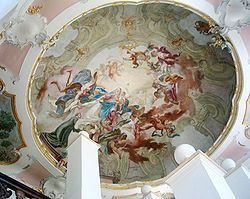Capital Schussenried Abbey Historical era Middle Ages Preceded by Succeeded by | Government Principality Granted papal immunity 13 February 1211 1512 | |
 | ||
Similar Wiblingen Abbey, Schloss Rastatt, Weikersheim Castle, Petershausen Abbey, Salem Abbey | ||
Schussenried Abbey (Kloster Schussenried, Reichsabtei Schussenried) was a Premonstratensian monastery in Bad Schussenried, Upper Swabia, Baden-Württemberg, Germany.
Contents
History
In 1183 the monastery here was founded by the local landowners, Berengar and Konrad of Schussenried, and was settled from the Premonstratensian Rot an der Rot Abbey.
Pope Innocent III granted it his protection and guaranteed its immunity by a privilege of 13 February 1211. It acquired substantial endowments and built up a considerable territory, and was declared an imperial abbey (i.e., territorially independent) in 1440.
The abbey suffered tremendous damage and losses however in the Thirty Years' War: many of the monastic buildings were burnt down by the Swedes and the lands were largely laid waste.
Sufficient recovery had at length been made by the 18th century for comprehensive re-building to be undertaken, and the present name Neues Kloster ("new monastery") refers to the Baroque re-construction from 1752. The planning was the responsibility of Dominikus Zimmermann. The original plan of four wings with an integrated church was not completely carried out for financial reasons: the present three-winged construction consists of the north wing plus stumps of the intended east and west wings, and represents about a third of the projected building complex.
After the German Mediatisation of 1803 the abbey and its territory was given, in compensation for their losses to the west of the Rhine, to the Counts of Sternberg-Manderscheid, who used the abbey as their castle. In 1806 the territory was mediatised to the Kingdom of Württemberg, to whom the counts' heirs sold the buildings in 1835.
The State of Württemberg set up a foundry on part of the land, and in 1875 a nursing home was set up in the buildings. Until 1997 this was the State Psychiatric Hospital of Bad Schussenried, later known as the Centre for Psychiatry.
Since 1998 the "Neue Kloster" has been used as an exhibition and event centre.
Library
The Baroque library is the most spectacular part of the monastic buildings and one of the main sights of the Oberschwäbische Barockstraße. The room is extremely light. The locked bookcases are arranged in two storeys. The ornamentation is among the richest of the 18th century in the German-speaking world. The ceiling fresco completed by Franz Georg Hermann in 1757 shows in bewildering detail the workings of divine wisdom in apocalypse, scholarship, education and craft.
To the most recent sculptures created for the room belong the eight groups of False Church Teachers, opposite which stand eight large figures of True Church Teachers. They are by Fidelis Sporer and were finished in 1766.
Abbey church
The abbey church is now the parish church, dedicated to Saint Magnus. It contains elements of Romanesque Gothic and Baroque architecture. Among the most noteworthy features are the choir stalls by Georg Anton Macheln and the ceiling frescoes by Johannes Zick showing the life of Norbert of Xanten, founder of the Premonstratensians.
